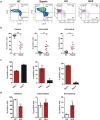Non-Classical monocytes display inflammatory features: Validation in Sepsis and Systemic Lupus Erythematous
- PMID: 26358827
- PMCID: PMC4566081
- DOI: 10.1038/srep13886
Non-Classical monocytes display inflammatory features: Validation in Sepsis and Systemic Lupus Erythematous
Abstract
Given the importance of monocytes in pathogenesis of infectious and other inflammatory disorders, delineating functional and phenotypic characterization of monocyte subsets has emerged as a critical requirement. Although human monocytes have been subdivided into three different populations based on surface expression of CD14 and CD16, published reports suffer from contradictions with respect to subset phenotypes and function. This has been attributed to discrepancies in reliable gating strategies for flow cytometric characterization and purification protocols contributing to significant changes in receptor expression. By using a combination of multicolour flow cytometry and a high-dimensional automated clustering algorithm to confirm robustness of gating strategy and analysis of ex-vivo activation of whole blood with LPS we demonstrate the following: a. 'Classical' monocytes are phagocytic with no inflammatory attributes, b. 'Non-classical' subtype display 'inflammatory' characteristics on activation and display properties for antigen presentation and c. 'Intermediate' subtype that constitutes a very small percentage in circulation (under physiological conditions) appear to be transitional monocytes that display both phagocytic and inflammatory function. Analysis of blood from patients with Sepsis, a pathogen driven acute inflammatory disease and Systemic Lupus Erythmatosus (SLE), a chronic inflammatory disorder validated the broad conclusions drawn in the study.
Figures







References
-
- Auffray C., Sieweke M. H. & Geissmann F. Blood monocytes: development, heterogeneity, and relationship with dendritic cells. Annu Rev Immunol 27, 669–692 (2009). - PubMed
-
- Gordon S. & Taylor P. R. Monocyte and macrophage heterogeneity. Nat Rev Immunol 5, 953–964 (2005). - PubMed
-
- Chow A., Brown B. D. & Merad M. Studying the mononuclear phagocyte system in the molecular age. Nat Rev Immunol 11, 788–798 (2011). - PubMed
-
- Hume D. A. The mononuclear phagocyte system. Curr Opin Immunol 18, 49–53 (2006). - PubMed
-
- Hume D. A. et al. The mononuclear phagocyte system revisited. J Leukoc Biol 72, 621–627 (2002). - PubMed
Publication types
MeSH terms
Substances
LinkOut - more resources
Full Text Sources
Other Literature Sources
Medical
Molecular Biology Databases
Research Materials

